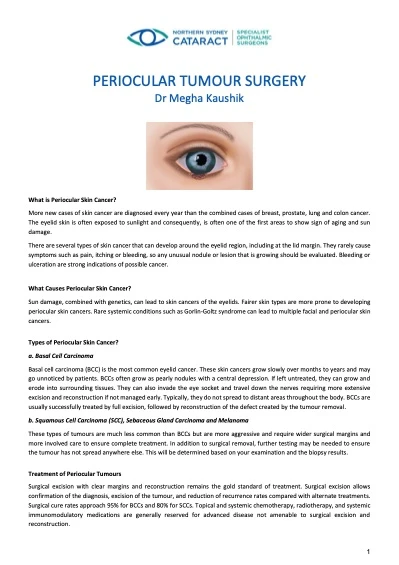60 Strathallen Avenue, Northbridge NSW
Monday to Friday - 9am to 5pm
Periocular Tumour Surgery
There are several types of skin cancer that can develop around the eyelid region, including at the lid margin. Surgical excision with clear margins and reconstruction remains the gold standard of treatment.
What is periocular skin cancer?
More new cases of skin cancer are diagnosed every year than the combined cases of breast, prostate, lung and colon cancer.
There are several types of skin cancer that can develop around the eyelid region, including at the lid margin. They rarely cause symptoms such as pain, itching or bleeding, so any unusual nodule or lesion that is growing should be evaluated. Bleeding or ulceration are strong indications of possible cancer.
What Causes Periocular Skin Cancer?
Sun damage, combined with genetics, can lead to skin cancers of the eyelids. Fairer skin types are more prone to developing periocular skin cancers. Rare systemic conditions such as Gorlin-Goltz syndrome can lead to multiple facial and periocular skin cancers.
Types of Periocular Skin Cancer
Basal Cell Carcinoma
Basal cell carcinoma (BCC) is the most common eyelid cancer. These skin cancers grow slowly over months to years and may go unnoticed by patients. BCCs often grow as pearly nodules with a central depression. If left untreated, they can grow and erode into surrounding tissues. They can also invade the eye socket and travel down the nerves requiring more extensive excision and reconstruction if not managed early. Typically, they do not spread to distant areas throughout the body. BCCs are usually successfully treated by full excision, followed by reconstruction of the defect created by the tumour removal.
Squamous Cell Carcinoma (SCC), Sebaceous Gland Carcinoma, Melanoma
These types of tumours are much less common than BCCs but are more aggressive and require wider surgical margins and more involved care to ensure complete treatment. In addition to surgical removal, further testing may be needed to ensure the tumour has not spread anywhere else. This will be determined based on your examination and the biopsy results.
Treatment of Periocular Tumours
Surgical excision with clear margins and reconstruction remains the gold standard of treatment. Surgical excision allows confirmation of the diagnosis, excision of the tumour, and reduction of recurrence rates compared with alternate treatments. Surgical cure rates approach 95% for BCCs and 80% for SCCs. Topical and systemic chemotherapy, radiotherapy, and systemic immunomodulatory medications are generally reserved for advanced disease not amenable to surgical excision and reconstruction.
Surgery for periocular tumours
Surgery consists of two components. Firstly, complete excision of the lesion and secondly, tissue reconstruction of the resultant defect after excision. The reconstruction requires specialised oculoplastic techniques that aim to restore aesthetics as well as the functional role of the eyelid in protecting the eye.
Eyelid tumours often extend beyond the visible margins. Thus, excisions may be larger than expected and may involve the full thickness of the eyelid or vital adjacent tissues.
Small defects can be directly closed with stitches, even if they involve the full thickness of the eyelid. Larger defects may require complex reconstruction, involving the transfer of adjacent tissues (“flaps”) or skin grafts from other parts of the face, eyelids or body.
Frozen Section Margin Control
For certain skin cancers, frozen section controlled surgery may be recommended. This involves a specialised pathologist attending the operation and performing real time microscopic confirmation of tumour clearance. Frozen section is extremely
useful as it allows definitive tumour removal whilst preserving the greatest amount of normal tissue. It also allows immediate reconstruction without the need to wait for pathology results. There is an additional fee for the specialist pathologist
performing the frozen sections.
What to Expect During Recovery from Periocular Tumours Surgery?
- Bruising and swelling can be expected for 2-6 weeks after surgery. This is a normal part of recovery after surgery and invariably settles with time.
- Itch along the incision site can occur and usually resolves with removal of sutures
- A gritty feeling to the eyes post-surgery is normal, particularly in the first 2 weeks
- Your vision may be slightly blurred for the first week post operatively
- Rarely, further excision of the tumour and reconstruction are needed if formal margins are not clear (as determined by formalin pathology examination)
- The eyelids can take 6 months to a year to completely settle post excision of tumours and reconstruction
What are the risks?
- Although uncommon there is a small chance of excess scarring, bruising, swelling, or wound infection.
- There may be asymmetry of the eyelids.
- Depending on the extent of the tumour, functional changes may arise such as dry eye or watering.
- The tumour may recur over time, which may need further treatment. Close surveillance is required.
- There is a theoretical risk of vision loss and double vision, although this is rare.
Want to know more about periocular tumour surgery? At Northern Sydney Cataract, we are here to help!
If you have specific questions, please call our friendly staff on 02 9958 0552 or email us at info@nscataract.com.au
For appointments and enquiries, please phone 02 9958 0552
Monday to Friday 9am - 5pm
© 2015– Northern Sydney Cataract | Privacy Policy | Disclaimer | Website by:

